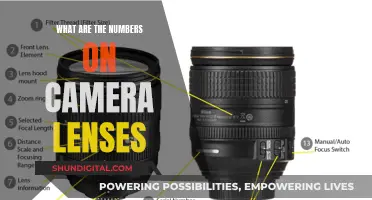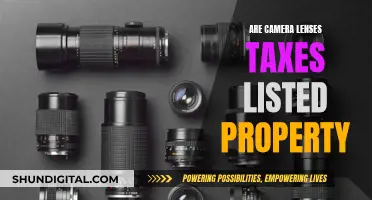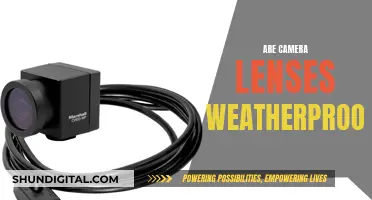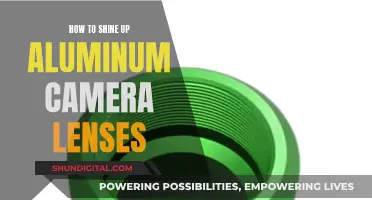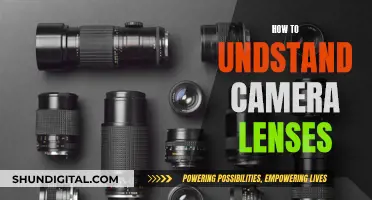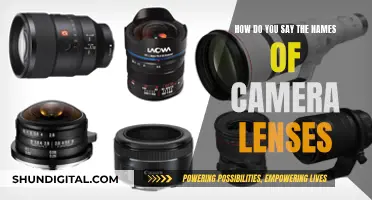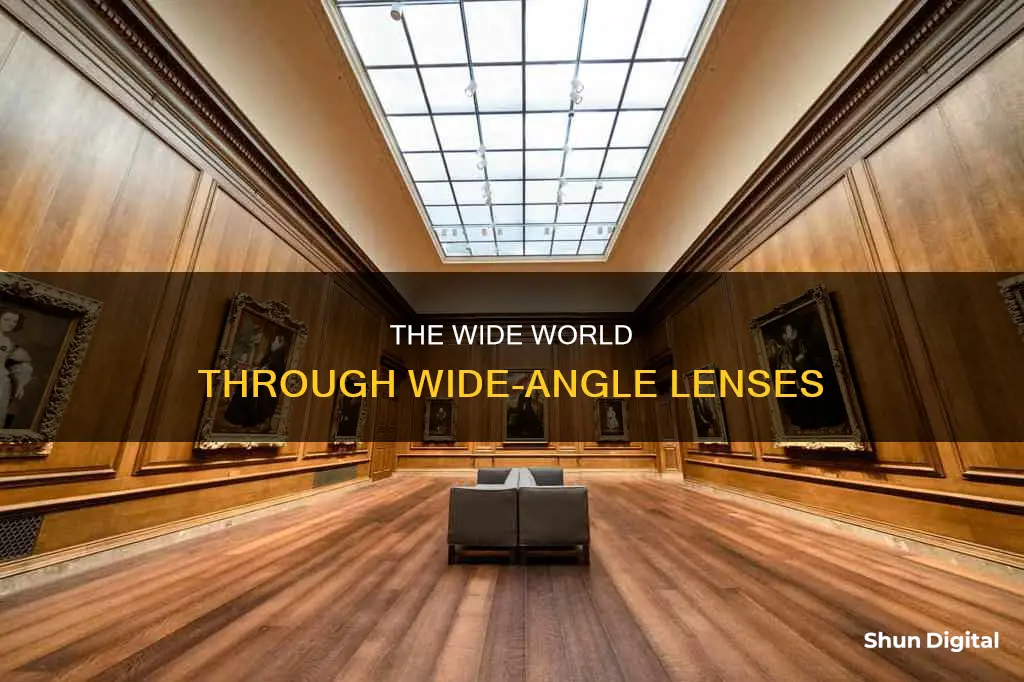
The angle of view of a camera lens, also known as the field of view, is the angular extent of a scene captured by the camera. This angle depends on the lens's focal length and the size of the camera's sensor. Lenses with shorter focal lengths, such as wide-angle lenses, have wider angles of view, capturing a larger area but making the subject appear smaller. On the other hand, lenses with longer focal lengths, like telephoto lenses, have narrower angles of view, capturing a smaller area but making the subject seem larger. The focal length of a lens is the distance between the optical centre of the lens and the image sensor, usually measured in millimetres. The angle of view is important as it helps photographers choose the right lens for their desired shot composition and creative vision.
| Characteristics | Values |
|---|---|
| Angle of View (AOV) | The angular extent of a scene imaged by a camera |
| Angle of Coverage | The angle range a lens can image |
| Focal Length | Distance between the optical centre of a lens and the image sensor |
| Field of View (FOV) | How much of a scene the camera's sensor captures |
What You'll Learn

Camera lenses have different focal lengths
Lenses can be categorised into two types: zoom lenses and prime lenses. Zoom lenses have variable focal lengths, allowing photographers to zoom in and out. For example, a 70-200mm zoom lens can be used to capture both close-up and distant subjects. Zoom lenses are versatile and commonly used by wedding photographers. On the other hand, prime lenses have a fixed focal length, meaning the photographer must physically move closer to or further from the subject to change the perspective of the image. Prime lenses produce higher-quality images than zoom lenses but are specialised for specific types of photography. For instance, a 50mm prime lens, also known as the "Nifty Fifty", is ideal for portraits as its focal length is considered to be the closest to the human eye.
Focal length also determines whether a lens is a wide-angle or telephoto lens. Wide-angle lenses have shorter focal lengths, resulting in a wider angle of view, while telephoto lenses have longer focal lengths and a narrower angle of view. Wide-angle lenses are commonly used for landscape, architecture, and vlogging, as they can capture more of the scene in front of them. In contrast, telephoto lenses are ideal for photographing distant subjects without needing to move closer, such as in wildlife, sports, or astronomy photography.
The angle of view of a lens also depends on the size of the camera's sensor. Digital sensors are typically smaller than 35mm film, resulting in a narrower angle of view. The crop factor, which varies depending on the type of camera, is used to calculate the effective focal length of a lens when used with a digital sensor.
Dual-Lens Setup for Unity Cameras: Achieving the Ultimate View
You may want to see also

Focal length determines the angle of view
The focal length of a camera lens is the distance between the plane of the sensor and the optical centre or nodal point of the lens. This distance, usually measured in millimetres, determines the lens's angle of view. The longer the focal length, the narrower the area of the scene captured by the lens. Conversely, a shorter focal length captures a much broader view.
Wide-Angle Lenses
Wide-angle lenses have short focal lengths, resulting in a wide angle of view. The area captured is large, but the subject appears small in the frame. Wide-angle lenses are ideal for landscape photography, large group portraits, and capturing expansive vistas. They are also useful for architectural photography, as they allow photographers to capture wide perspectives within the frame.
Telephoto Lenses
Telephoto lenses have longer focal lengths, resulting in a narrow angle of view. They capture a smaller area, but the subject appears larger in the frame. Longer focal lengths also compress the image, making the background appear closer and larger than it would with a standard lens. Telephoto lenses are commonly used for sports and wildlife photography, as they allow photographers to capture distant subjects without having to move closer to them.
Standard Lenses
Standard lenses have focal lengths of around 50mm and are sometimes referred to as "normal" lenses. They provide a natural perspective similar to that of the human eye, with minimal distortion. Standard lenses are versatile and can be used for various genres, including travel, street, floral, and portrait photography.
Ultra Wide-Angle Lenses (Fisheye Lenses)
Ultra wide-angle lenses, also known as fisheye lenses, have extremely short focal lengths, typically ranging from 8-15mm. They offer a very wide angle of view, often exceeding 100 degrees. Fisheye lenses can capture images in a full circle, surrounded by black, creating an abstract effect. They are popular in extreme sports photography, where the distortion adds to the sense of motion.
Focal Length and Sensor Size
It's important to note that the angle of view is influenced not only by the focal length but also by the size of the camera's sensor. Digital sensors are usually smaller than 35mm film, resulting in a narrower angle of view for the same lens. This effect is known as the crop factor. Different camera systems have different crop factors, which can affect the effective focal length of a lens.
Understanding Camera Lenses: Objective Focal Lengths Explained
You may want to see also

Wide-angle lenses have a wider angle of view
The angle of view of a lens is determined by its focal length. Wide-angle lenses have shorter focal lengths than other types of lenses, which is why they have a wider angle of view. Focal length refers to the distance between the optical centre or nodal point of the lens and the plane of the sensor. The shorter this distance is, the wider the angle of view.
The focal length of a lens also determines how much the subject will be magnified. Wide-angle lenses have shorter focal lengths, which means that the subject will appear smaller in the frame. This is because a shorter focal length results in a wider angle of view, capturing more of the surrounding area and making the subject appear smaller in comparison.
It is worth noting that the angle of view of a lens also depends on the size of the camera's sensor. Digital sensors are usually smaller than 35mm film, which causes the lens to have a narrower angle of view than with 35mm film. This is known as the crop factor. Therefore, the same lens will have a different angle of view depending on the sensor size.
Protecting Camera Lenses: Sun Shields and Filters
You may want to see also

Telephoto lenses have a narrower angle of view
The angle of view in photography describes the angular extent of a scene captured by a camera. This is determined by the focal length of the lens, which is the distance between the optical centre of the lens and the image sensor. Lenses with shorter focal lengths have wider angles of view, while those with longer focal lengths have narrower angles of view.
Telephoto lenses are those with longer focal lengths, typically starting at around 85mm. They are used for capturing distant subjects without having to move closer to them. This makes them ideal for photographing people at social events, outdoor portraits, sports events, and wildlife photography.
The longer focal length of telephoto lenses also results in lens compression, which makes the background appear closer and larger than it would with a standard lens. This effect is particularly noticeable in super telephoto lenses, which have focal lengths greater than 300mm. These lenses are often used in wildlife and sports photography, where their long focal lengths allow photographers to capture fast-moving subjects from a distance.
The narrow angle of view of telephoto lenses also means that they are more susceptible to camera shake, as small hand movements are magnified in the viewfinder. This can make it challenging to achieve sharp handheld photographs with telephoto lenses, and photographers may need to use faster shutter speeds or a tripod to compensate.
Handcrafted Zeiss Lenses: Precision and Artistry in Optics
You may want to see also

The angle of view can be measured diagonally, horizontally, or vertically
The angle of view in camera lenses is an angular measurement that determines your field of view. It is the angle indicating the width of the field included in the photo. A wide-angle lens has a wider angle of view than a telephoto lens. The angle of view can be measured diagonally, horizontally, or vertically.
Diagonal angle of view measurements are taken from one corner of the camera frame to the opposite corner. This is the measurement that lens manufacturers include in their spec sheets. This is similar to how TV manufacturers measure the size of a TV screen, which is the diagonal length of the screen.
Horizontal angle of view measurements are taken from the left to the right edge of the frame. Vertical angle of view measurements are taken from the top to the bottom of the frame.
Calculating the angle of view can be done using the chosen dimension (d) and the effective focal length (f) of the lens. The formula for this is:
> {\displaystyle \alpha =2\arctan {\frac {d}{2f}}}
The angle of view also depends on the camera's sensor. Digital sensors are usually smaller than 35mm film, causing the lens to have a narrower angle of view than with 35mm film. This is known as the crop factor.
Additionally, the angle of view can be determined using FOV tables or paper or software lens calculators.
Cameras and Lenses: Capturing the 3D World
You may want to see also
Frequently asked questions
The angle of view (AOV) describes the angular extent of a scene captured by a camera. It is used interchangeably with the field of view.
The angle of view of a lens can be calculated using the chosen dimension (d) and effective focal length (f) with the formula: α = 2arctan(d/2f).
The angle of coverage describes the angular range that a lens can image. The angle of view, on the other hand, depends on both the lens and the sensor size.
Digital sensors are typically smaller than 35mm film, resulting in a narrower angle of view. The crop factor, which varies with sensor size, determines the effective focal length and angle of view.
Wide-angle lenses have shorter focal lengths, resulting in a wider angle of view. Telephoto lenses have longer focal lengths, yielding a narrower angle of view.


